 |
 06-28-2009, 06:46 PM
06-28-2009, 06:46 PM
|
#1
|
|
Commander
Join Date: Oct 2004
Posts: 156
|
OK.. The Mast mounted halyard winch was impossible to use when one man was on the sheets. This made singlehanding s/v William Bligh tough if there was any wind in the main. The headsails have not been a problem to raise, but it took both Brian and I to raise the main while underway, as the halyard winch starts to slip at a certain undetermined amount of strain.
Here are some pix.. I found that there is an effing "catch" missing on the top part of it.. Maybe someone can help correct my terminology.. The following pictures are in order and the kitten's name is Alawai, who I rescued two weeks ago in Michigan.. her eye is like that because her mother had Feline Herpes, and the microsurgery to fix it is only a temporary fix, as it'll say like that. The Vet I took her to in Nova Scotia last week did some research and called the condition Symblepharon.
She will be fine.
The winch was made by Marinium... I'd like to replace it with one with a greater ratio.
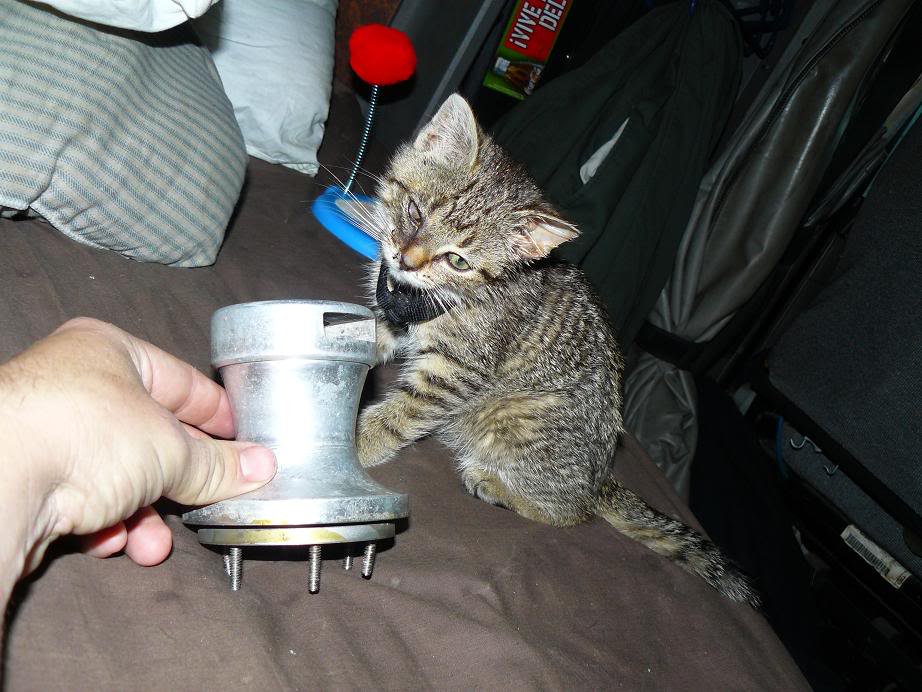
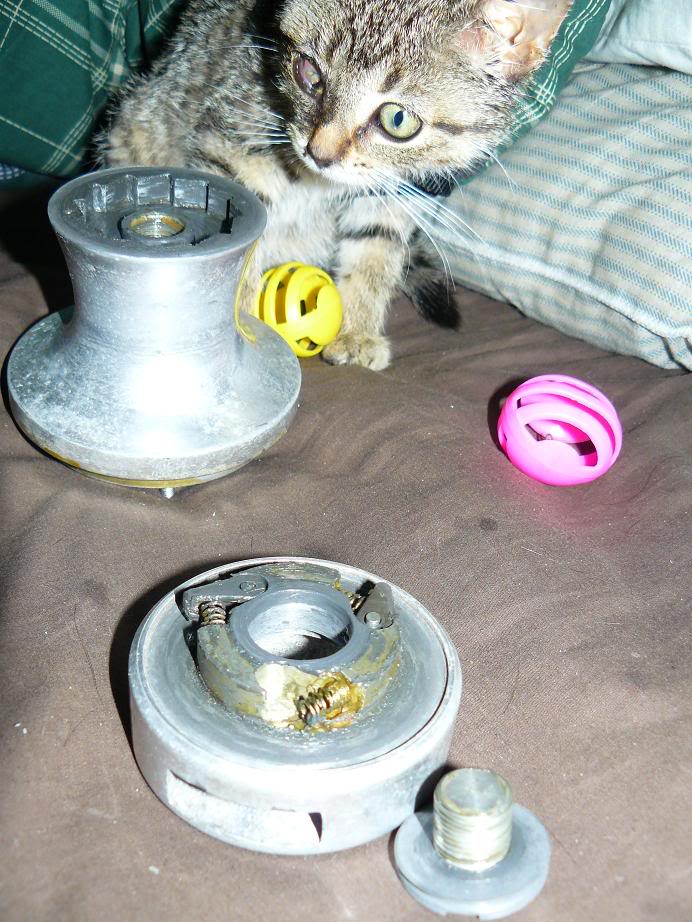

Missing catch.
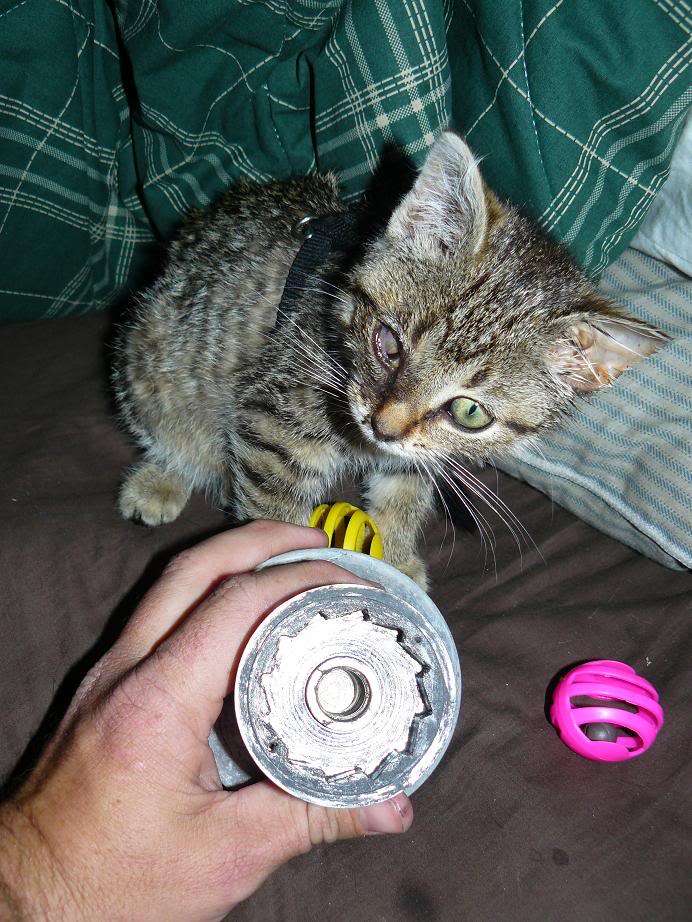
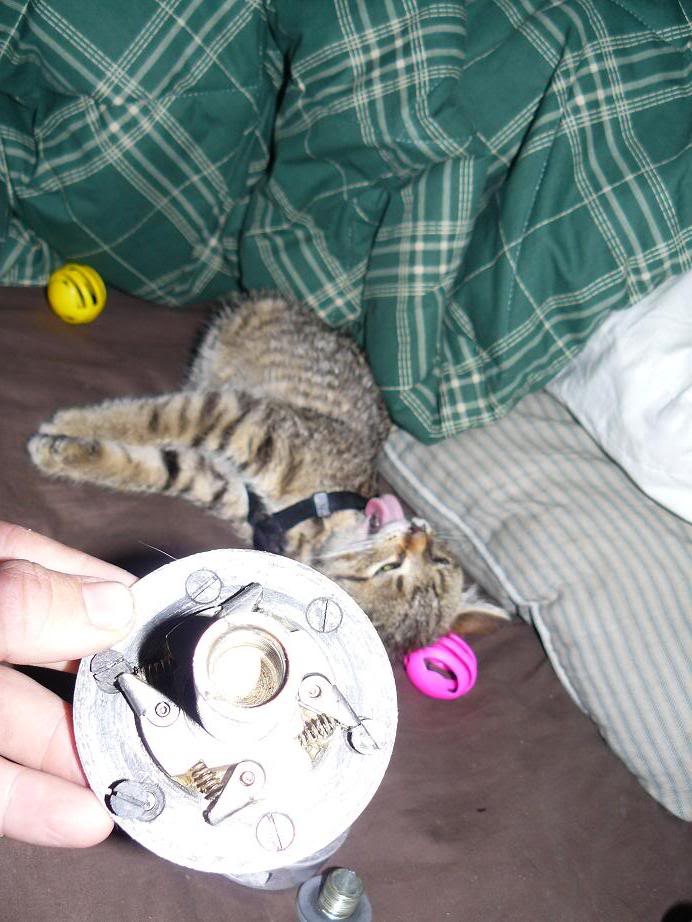
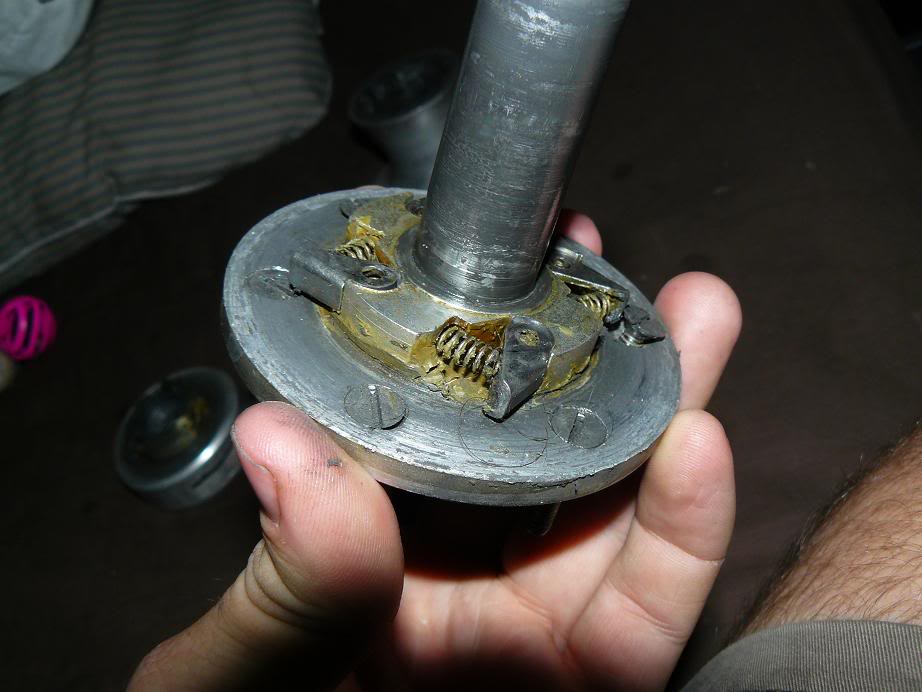
__________________
|

|

|
 06-29-2009, 02:19 AM
06-29-2009, 02:19 AM
|
#2
|
|
Moderator
Join Date: Jun 2007
Home Port: Washington DC
Vessel Name: SV Mahdee
Posts: 3,236
|

The winch is slipping or the rope is slipping on the winch?
Someone else can correct me if I'm wrong, but I believe the part missing is one of the pawls. Is the winch made by Merriman Holbrook ("Merriman")? If so, you might be able to find the pawls even though the winches have been out of production for quite some time. There are three different sizes, the suffix on the handle might tell you which you have (if the handle is original). The power ratio is 8:1.
Is it possible that your halyard sheave at the top of the mast is not turning properly? This can make it very difficult to raise the main. Further, if the sheave is for wire but you're now using an all rope halyard, that can be a problem, too. If the problem is simply the winch, a short term fix is to put a block at the base of your mast so that you can run the halyard to another winch if one is available. Else, you might be able to set up a couple snatch blocks on the halyard (above the position of this winch) to enable increased purchase. Even a 2:1 purchase would help your situation.
How long is the boat? Sorry, I've forgotten. How big is your mainsail (square ft)? I ask because it is often possible to raise a main without mechanical assistance as long as you have something taking the load like a rope clutch or a belaying pin as you haul. If your sail isn't all that big, it seems like the sheave could be your culprit.
Fair winds,
__________________
|

|

|
 06-29-2009, 09:07 AM
06-29-2009, 09:07 AM
|
#3
|
|
Commander
Join Date: Oct 2004
Posts: 156
|

Quote:
Originally Posted by redbopeep

The winch is slipping or the rope is slipping on the winch?
Someone else can correct me if I'm wrong, but I believe the part missing is one of the pawls. Is the winch made by Merriman Holbrook ("Merriman")? If so, you might be able to find the pawls even though the winches have been out of production for quite some time. There are three different sizes, the suffix on the handle might tell you which you have (if the handle is original). The power ratio is 8:1.
Is it possible that your halyard sheave at the top of the mast is not turning properly? This can make it very difficult to raise the main. Further, if the sheave is for wire but you're now using an all rope halyard, that can be a problem, too. If the problem is simply the winch, a short term fix is to put a block at the base of your mast so that you can run the halyard to another winch if one is available. Else, you might be able to set up a couple snatch blocks on the halyard (above the position of this winch) to enable increased purchase. Even a 2:1 purchase would help your situation.
How long is the boat? Sorry, I've forgotten. How big is your mainsail (square ft)? I ask because it is often possible to raise a main without mechanical assistance as long as you have something taking the load like a rope clutch or a belaying pin as you haul. If your sail isn't all that big, it seems like the sheave could be your culprit.
Fair winds,
|
The halyards are wire and rope and brand new, the sheeves are brand new and it's the winch that is slipping. The boat's 25' but it has a tall mast for it's length, can't remember exactly, nearly 30'. The boom is quite long as well, reaching nearly all the way to the backstay.
What happens is this. Say you have the main halyard wrapped around it twice, and you nearly have the main all the way up, but not quite.. when it reaches a certain amount of torque, it starts turning backwards, it's not the rope slipping, I would have noticed. Plus, it's easy to raise all the way if there's no wind in the sail, but if if you're sailing already and there's wind in it, it's nearly impossible without two people.
The sheeves were fixed, as I mentioned last year by Portland Yacht Services, and I tested them before the mast went up.
__________________
|

|

|
 06-29-2009, 10:58 AM
06-29-2009, 10:58 AM
|
#4
|
|
Admiral
Join Date: Oct 2004
Posts: 3,067
|
Hello Robin,
Agree with Brenda that the winch is a Merriman .
The top section of the winch, which is turned by the winch handle Has 3 Pawls - one of which is missing (maybe not - maybe it is still around) The pin that the pawl fits onto has broken off :--
Blue arrow :-- 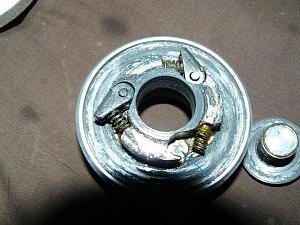
It may be possible to repair !
#1 drill out the broken pin.
#2 Tap a new thread to take a pillar stud (or use a bolt which can be screwed in - cutting it to the height of a pawl)
#3 Screw stud or bolt into newly tapped hole - place pawl in position (spring loaded)
If you can't find the missing one, it won't be difficult to make a new one . Might even try taking one of the 4 pawls which are in the bottom section of the Winch.
Good Luck
Richard
__________________

|

|

|
 06-29-2009, 04:41 PM
06-29-2009, 04:41 PM
|
#5
|
|
Moderator
Join Date: Jun 2007
Home Port: Washington DC
Vessel Name: SV Mahdee
Posts: 3,236
|

Quote:
Originally Posted by Robinsvoyage

The halyards are wire and rope and brand new, the sheeves are brand new and it's the winch that is slipping. The boat's 25' but it has a tall mast for it's length, can't remember exactly, nearly 30'. The boom is quite long as well, reaching nearly all the way to the backstay.
What happens is this. Say you have the main halyard wrapped around it twice, and you nearly have the main all the way up, but not quite.. when it reaches a certain amount of torque, it starts turning backwards, it's not the rope slipping, I would have noticed. Plus, it's easy to raise all the way if there's no wind in the sail, but if if you're sailing already and there's wind in it, it's nearly impossible without two people.
The sheeves were fixed, as I mentioned last year by Portland Yacht Services, and I tested them before the mast went up.
|
Hi there,
Why are you adjusting your main halyard with wind already in the sail? Are you taking out a reef? Good practice is to come up into the wind (put yourself in irons) to relieve the load if you must make an adjustment/tighten the main halyard.
Your boat is small enough to not even need winches for the halyards--but instead to work entirely with snatch blocks with only 2:1 or 3:1 purchase depending on how the line is fed. So, on the surface it seems your 8:1 winches should be more than enough for the situation.
You can tighten things up without a winch, by yourself simply swigging the halyard; --tail in one hand to pull the halyard around a low cleat, swig with the other arm. I do this with our running back stays on our 54' boat and can achieve enough force to bend the mast if I'm not careful. If you're not comfortable with swigging a halyard onto a cleat or belaying pin, you could simplify your life by putting a rope clutch low on the mast which would enable you to swig the halyard by yourself. When you're done, always take the load onto a cleat rather than just relying on the rope clutch.
MMNETSEA's pawl fix should get you what you need to have them fully operating. Some shops (Like Minney's in Costa Mesa CA) sell used gear and carry pawls for older winches, too. They sometimes part-out old winches.
*****
Definition of swigging and how to swig (from Answer.com) The maximum horizontal pull a person can exert on a line, given a good foothold, is around 150 pounds (68 kg). But when you’re pulling downward—on a halyard, for example—your maximum pull equals your body weight.You can easily tighten a halyard to more than your body weight by swigging it. Swigging (or sweating up) is the old term for putting far greater tension in a halyard that would be possible with a straight pull.To swig a halyard, hoist it as tightly as you can and then take a half turn around a cleat to prevent its slipping. With one hand, grasp the halyard as high as you can, and pull it out—away from the mast—using your body weight. Then take up the slack you have won in this way by pulling with your other hand as you let the line go back toward the mast. The lower end of the halyard will slip around the cleat and be held in position as you haul tight on it. Repeat the process several times and in a brace of shakes, the halyard will be bar taut.It requires some dexterity and timing, but it’s a valuable skill that comes quickly with practice. On large yachts, two people can work together, one swigging and the other taking up the slack. Swigging can also be used on docklines and anchor lines.
|

|

|
 07-15-2009, 05:30 PM
07-15-2009, 05:30 PM
|
#6
|
|
Ensign
Join Date: Jul 2007
Posts: 12
|
Good info on "Swigging", isn't that also referred to as "Jumping" (at least in the racing world) ?
PS - cute kitten, kudos for the rescue !!!
__________________
__________________
|

|

|
 |
|
Currently Active Users Viewing This Thread: 1 (0 members and 1 guests)
|
|
|
 Posting Rules
Posting Rules
|
You may not post new threads
You may not post replies
You may not post attachments
You may not edit your posts
HTML code is Off
|
|
|
|
 Recent Threads
Recent Threads |
|
|
|
|
|
|
|
|
|
|
|
|
|


















 Linear Mode
Linear Mode






























